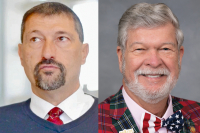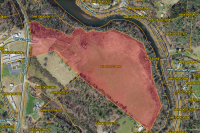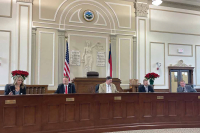WCU eyes long-term infrastructure needs
Plans made in the coming months could set the tone for the following decade or two of construction, renovation and development on Western Carolina University’s campus.
Faculty, staff, administrators and students at the school have been working since September to craft the institution’s next campus master plan — a process that is expected to last about 16 months and create a final product that is a general guideline for all aspects of the university’s infrastructure development.
The plan will address a wide range of infrastructure needs, from sustainable buildings and parking availability to preservation of historic structures.
Steering Committee co-chairman Sam Miller, also vice chancellor for student affairs, said the plan should hold big consequences for upcoming campus hotspots such as the recently acquired 334-acre Millennial Campus. The university just finished a new health and human services building there, though much of the Millenial Campus potential remains untapped.
“We have the new Millennial properties — how do we capitalize on that investment and what infrastructure would we need to support that?” Miller asked as an example of a question that may be answered by the new campus master plan.
The master plan doesn’t go so far as to lay out specifics of construction plans or funding sources, but acts more as a blueprint for the campus’ progress. The last campus master plan was drafted in 1997, and Miller said much of the vision contained in that plan eventually came to fruition.
Related Items
The campus master plan supplements the more comprehensive strategic plan drafted for the university. The new 2020 strategic plan, which the university just completed this summer, outlines overarching goals of the university, whereas the campus master plan tackles the infrastructure necessary to obtain those goals.
“It’s just now we have a new strategic plan with a new direction,” Miller said. “So the time was right that we revisit the infrastructure plan — to match the goals of the facilities to the goals of university.”
Currently, the steering committee is wrapping up a campus tour of all WCU’s facilities.
Each of the members brings a unique perspective to the vision of campus. For example, Peg Connolly, the Recreational Therapy Program director at WCU, said wherever she goes on campus she is thinking about accessibility for people with wheelchairs and walkers as well as transportation infrastructure such as sidewalks.
Likewise, Mark Lord, a professor of geology at WCU, said he is looking out for how certain classrooms could be updated for learning in the 21st Century.
“What I hope to bring is mostly focused on the academic side,” Lord said. “As we build the campus we hope it represents the educational mission of the university.”
Bringing buildings up to date could be a challenge. The university’s buildings range from the new top-notch health and human sciences building to classrooms that haven’t been updated since the 1970s, he said.
“It’s a daunting task overall because of the breadth of what it covers,” Lord said. “Some if it is boring, like when the roof leaks you fix it … But other stuff is more exciting like renovating and building to reflect who we are as a university.”
Here comes Cullowhee
The long process to draft the plan will include creating separate task forces to specialize in certain areas of infrastructure as well as a series of meetings with the public.
Although a steering committee of more than 15 selected members has been meeting since September to formulate the plan, last Monday night (Nov. 5) marked the first of the committee’s community forums.
Cullowhee residents packed into the Cullowhee Valley School’s library that evening to offer input and ask questions.
“We’re just getting started,” said steering committee co-chairwoman Melissa Wargo. “But this is a chance for people interested to tell us on the front end ‘here’s something we really hope you consider’ and ‘here is something we’re really fearful of.’”
And the crowd let them hear it.
The group of about 20 residents, including future Jackson County Commissioner Vicki Greene and members of the local community planning group Cullowhee Revitalization Endeavor, voiced complaints and recommendation from across the spectrum.
One woman said she’d like to see covered bike storage on campus, while another man said development along the river would be nice. The county is currently working on a greenway plan officials hope to connect with the university.
Others attending the meeting complained about the lack of parking and sidewalks connecting to campus — to which Wargo acknowledged that the campus doesn’t really have a parking problem, instead it has a walking problem.
Yet another, Clark Corwin, floated the prospect that WCU acquire an abandoned golf course in the township and develop it into an arboretum with walking paths.
With isolated pockets of student and faculty housing and no connection to campus apart from driving or taking a campus shuttle, his major criticism of transportation infrastructure on and around campus was the lack of walking opportunities.
“We don’t have that. We get in our car to go to the Mad Batter,” Corwin said of a popular local bakery on campus. “If you can find a parking place.”
Much of the community input blurred the boundaries between on-campus and off-campus. And, it soon became clear that although the focus of the campus master plan is for WCU property, many of the infrastructure goals of the community reached across the institution’s property lines.
Jackson County Planning Director Gerald Green, who is also on the steering committee, at one point spoke up to remind the crowd that some of the work rests in the hands of Cullowhee residents. Some members of the community have been pushing hard to put zoning ordinances in place in Cullowhee to help guide development.
“Not all is riding on the university,” Green said. “A lot of it will fall on the county to put those requirements in.”
Green said student apartment proposals for the area have come across his desk and there is no way to force them to include things likes sidewalks or other forms of infrastructure that could link with the university unless the county puts ordinances in place.
But one Cullowhee resident, Roy Osborn, was not willing to let the university officials off the hook that easily. He said the development of a functioning campus goes hand in hand with the development of a functioning community. And the university should do more to support the other’s efforts.
“Cullowhee master plan and a campus master plan — you can’t have one without the other,” Osborn said. “There needs to be integration between the university and Cullowhee.”









